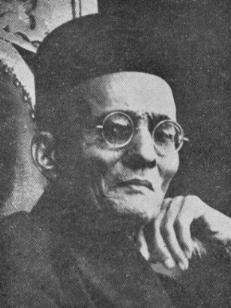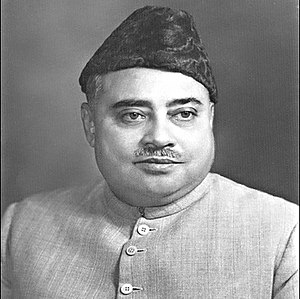Hindu–Muslim unity
Hindu–Muslim unity is a religiopolitical concept in the Indian subcontinent which stresses members of the two largest faith groups there, Hindus and Muslims working together for the common good. The concept was championed by various rulers of India, such as Mughal Emperor Akbar,[1] leaders in the Indian independence movement, such as Mahatma Gandhi and Khan Abdul Ghaffar Khan,[2] as well as by political parties and movements, such as the Indian National Congress, Khudai Khidmatgar and All India Azad Muslim Conference.[3] Those who opposed the partition of colonial India often adhered to the doctrine of composite nationalism.[4]

History
In Mughal India, the emperor Akbar advocated for Hindu–Muslim unity, appointing both Hindus and Muslims as officials in his court.[5] Akbar participated and promoted festivals of both Hinduism and Islam,[6] he also created feasts such as Phool Walon Ki Sair (although this festival is said to have been started much later in the nineteenth century under Akbar II) to be celebrated by citizens of all faiths.[7]
Chhatrapati Shivaji also promoted Hindu-Muslim unity. Maratha Hindavi Swarajya had many Muslims in high posts. Shivaji's personal security, his most trusted courtiers were Muslims. A Muslim general had led the Maratha troops in the third battle of Panipat and sacrificed for the cause.
Sayyid Jamal al-Din al-Afghani Asadabadi advocated for Hindu-Muslim unity, holding that it would effectively combat British imperialism, leading to an independent India.[8][9]
In the First War of Indian Independence in 1857, the Hindus and Muslims of India mobilized to fight the British.[10] Reflecting on this in 2007, Manmohan Singh stated that these events "stood as a great testimony to the traditions of Hindu–Muslim unity that held out as an example for subsequent generations".[10]
The Lucknow Pact of 1916 was seen as an "important step forward in achieving Hindu–Muslim unity" during the era of the Indian independence movement.[11] Muhammad Ali Jinnah advocated Hindu–Muslim unity in early years of his political career.[12] Gopal Krishna Gokhale stated that Jinnah "has true stuff in him, and that freedom from all sectarian prejudice which will make him the best ambassador of Hindu–Muslim Unity".[13]
Muslim scholars of the Deoband school of thought, such as Qari Muhammad Tayyib and Kifayatullah Dihlawi, championed Hindu–Muslim unity, composite nationalism, and called for a united India.[14] Maulana Sayyid Hussain Ahmad Madani, the leader of the Jamiat Ulema-e-Hind, stated:[15]
Hindu-Muslim unity is a prerequisite for freedom of India. It is the religious and political duty of the Muslims that they should work for the freedom of India and continue this struggle until the Government accedes to their demand. It is their duty, which they must do with or without companions, it is the order of the Almighty. If non-Muslims extend to you the hand of friendship, you too must extend yours, for compromising for the right cause will establish you as true believers in Allah.[15]
Malik Khizar Hayat Tiwana, the Premier of Punjab in colonial India, advocated for amity between the religious communities of undivided India, proclaiming March 1st as Communal Harmony Day and aiding in the establishment of a Communal Harmony Committee in Lahore, in which Raja Narendra Nath served as president and Maulvi Mahomed Ilyas as secretary.[16]
Threats to Hindu–Muslim unity

In the First War of Indian Independence (also known as the Indian Rebellion) in 1857, Hindus and Muslims in India joined together as Indians to fight the British.[17] The British became concerned about this rise in Indian nationalism and therefore tried to stir up communalistic feelings among Hindus and Muslims so that they might not again unite to try and overthrow crown rule.[17] For example, Theodore Beck, the principal of Muhammadan Anglo-Oriental College, had told Syed Ahmad Khan that Muslims should have no sympathy with the objectives of the Indian National Congress and "that Anglo-Muslims unity was possible, but Hindu–Muslims unity was impossible".[17]
The author of Composite Nationalism and Islam, Maulana Husain Ahmad Madani, a Deobandi Muslim scholar and proponent of a united India, argued that the British were attempting to "scare Muslims into imagining that in a free India Muslims would lose their separate identity, and be absorbed into the Hindu fold", a threat that "aim[ed] at depoliticizing the Muslims, weaning them away from struggle for independence."[17] In the eyes of Madani, support for a two-nation theory resulted in the entrenchment of British imperialism.[17]
In the same vein, Kashmiri Indian politician and Supreme Court judge Markandey Katju wrote in The Nation:[18]
Up to 1857, there were no communal problems in India; all communal riots and animosity began after 1857. No doubt even before 1857, there were differences between Hindus and Muslims, the Hindus going to temples and the Muslims going to mosques, but there was no animosity. In fact, the Hindus and Muslims used to help each other; Hindus used to participate in Eid celebrations, and Muslims in Holi and Diwali. The Muslim rulers like the Mughals, Nawab of Awadh and Murshidabad, Tipu Sultan, etc were totally secular; they organised Ramlilas, participated in Holi, Diwali, etc. Ghalib’s affectionate letters to his Hindu friends like Munshi Shiv Naraln Aram, Har Gopal Tofta, etc attest to the affection between Hindus and Muslims at that time. In 1857, the ‘Great Mutiny’ broke out in which the Hindus and Muslims jointly fought against the British. This shocked the British government so much that after suppressing the Mutiny, they decided to start the policy of divide and rule (see online “History in the Service of Imperialism” by B.N. Pande). All communal riots began after 1857, artificially engineered by the British authorities. The British collector would secretly call the Hindu Pandit, pay him money, and tell him to speak against Muslims, and similarly he would secretly call the Maulvi, pay him money, and tell him to speak against Hindus. This communal poison was injected into our body politic year after year and decade after decade.[18]
However, historical evidence suggests that the conflicts between the Hindu-Muslim population existed long before Britishers set foot in India.[19] Even in places where Britishers had least influence (like princely states), the number of communal riots was more frequent as compared to places which were directly under British rule (like British provinces).[19]
The Sangh Parivar which advocates the Hindutva philosophy formulated by right-wing Hindu fundamentalist leader Vinayak Damodar Savarkar is also opposed to Hindu-Muslim unity. Since Hindutva links religious identity with national identity, they don't consider Muslims & Christians to be loyal to India inspite of their Indian ancestry. Savarkar advocated that the Indian subcontinent is by & for those who consider it 'holy' i.e Hindus, Buddhists, Jains & Sikhs and since Muslims, Christians & Jews consider Mecca & Jerusalem as their holy land, they can't live in India unless (1) they agree to live as second-class citizens with their religious rights curtailed, in retaliation of the atrocities committed upon Hindus during Muslim rule in India & British Raj or (2)convert back to Hinduism. At present thorny & sensitive issues like Babri Masjid demolition, ghettoisation & stereotyping of Muslims as terrorists & illegal infiltrators, increase in mob-lynching due to cow vigilante violence in India spearheaded by the rise of right wing Bharatiya Janata Party in Indian politics along with propagation of Hindutva ideology, labelling of political parties in India opposing BJP as 'anti-Hindu' & viewing of secularism as crypto Muslim-appeasement has affected Hindu Muslim unity in India to some extent.

Atrocities against minorities & radicalisation of the masses have also affected Hindu-Muslim unity in Pakistan & Bangladesh.
See also
References
- Masaeli, Mahmoud; Prabhakar, Monica (2018). India as a Model for Global Development. Cambridge Scholars Publishing. p. 30. ISBN 9781527518568.
- Bhave, Y. G. (1997). The Mahatma and the Muslims. Northern Book Centre. p. 39. ISBN 9788172110819.
- Veeravalli, Anuradha (2016). Gandhi in Political Theory: Truth, Law and Experiment. Routledge. p. 84. ISBN 9781317130994.
- Na, Abdullahi Ahmed An-Na'im; Naʻīm, ʻAbd Allāh Aḥmad (2009). Islam and the Secular State. Harvard University Press. p. 156. ISBN 978-0-674-03376-4.
The Jamiya-i-ulama-Hind founded in 1919, strongly opposed partition in the 1940s and was committed to composite nationalism.
- Bahadur, K. P. (1990). Rasikapriya of Keshavadasa. Motilal Banarsidass. p. i. ISBN 9788120807341.
- Bahadur, K.P. (1976). Selections from Rāmacandrikā of Keśavadāsa. Motilal Banarsidass Publishers. p. 1. ISBN 9788120827899.
- Indian and Foreign Review, Volume 23. Publications Division of the Ministry of Information and Broadcasting, Government of India. 1985. p. 82.
- "AFḠĀNĪ, JAMĀL-AL-DĪN". Encyclopaedia Iranica. 22 July 2011.
In Hyderabad 1880-81 Afḡānī published six Persian articles in the journal Moʿallem-e šafīq, which were reprinted in Urdu and Persian in various editions of Maqālāt-e Jamālīya. The three major themes of these articles are: 1. advocacy of linguistic or territorial nationalism, with an emphasis upon the unity of Indian Muslims and Hindus, not of Indian Muslims and foreign Muslims; 2. the benefits of philosophy and modern science; and 3. attacks on Sayyed Aḥmad Khan as a tool of the British. On nationalism, he writes in “The Philosophy of National Unity and the Truth about Unity of Language” that linguistic ties are stronger and more durable than religious ones (he was to make exactly the opposite point in the pan-Islamic al-ʿOrwat al-woṯqā a few years later). In India he felt the best anti-imperialist policy was Hindu-Muslim unity, while in Europe he felt it was pan-Islam.
- Aslam, Arshad (28 July 2011). "The Politics Of Deoband". Outlook.
Much before Madani, Jamaluddin Afghani argued that Hindus and Muslims must come together to overthrow the British. Husain Ahmad would argue the same thing after five decades.
- "'1857 revolt tribute to Hindu–Muslim unity'". Hindustan Times. 10 May 2007.
- The Pearson CSAT Manual 2011. Pearson Education India. 2011. ISBN 9788131758304.
An important step forward in achieving Hindu–Muslim unity was the Lucknow Pact, 1916.
- WELL, IAN BRYANT. AMBASSADOR OF HINDU–MUSLIM UNITY JINNAH'S EARLY POLITICS. Vanguard Books. ISBN 8178241447.
- Wolpert, pp. 34–35.
- MacLean, Derryl N. (2013). Cosmopolitanisms in Muslim Contexts. Edinburgh University Press. ISBN 9780748656097.
- McDermott, Rachel Fell; Gordon, Leonard A.; Embree, Ainslie T.; Pritchett, Frances W.; Dalton, Dennis (2014). Sources of Indian Traditions: Modern India, Pakistan, and Bangladesh. Columbia University Press. p. 457. ISBN 978-0-231-51092-9.
- Talbot, Ian (1996). Khizr Tiwana, The Punjab Unionist Party and the Partition of India. Curzon Press. p. 77, 303.
- Syeda, Lubna Shireen (2014), "Madani and Composite Nationalism", A study of Jamiat-Ulama-i-Hind with special reference to Maulana Hussain Ahmad Madani in freedom movement (A.D. 1919 – A.D.1947), Dr. Babasaheb Ambedkar Marathwada University/Shodhganga, pp. 207–211, 257–258
- Markandey Katju. "The truth about Pakistan". The Nation. Archived from the original on 10 November 2013. Retrieved 29 January 2019.
- Verghese, Ajay. "British Rule and Hindu-Muslim Riots in India: A Reassessment". Georgetown University. Retrieved 7 August 2020.